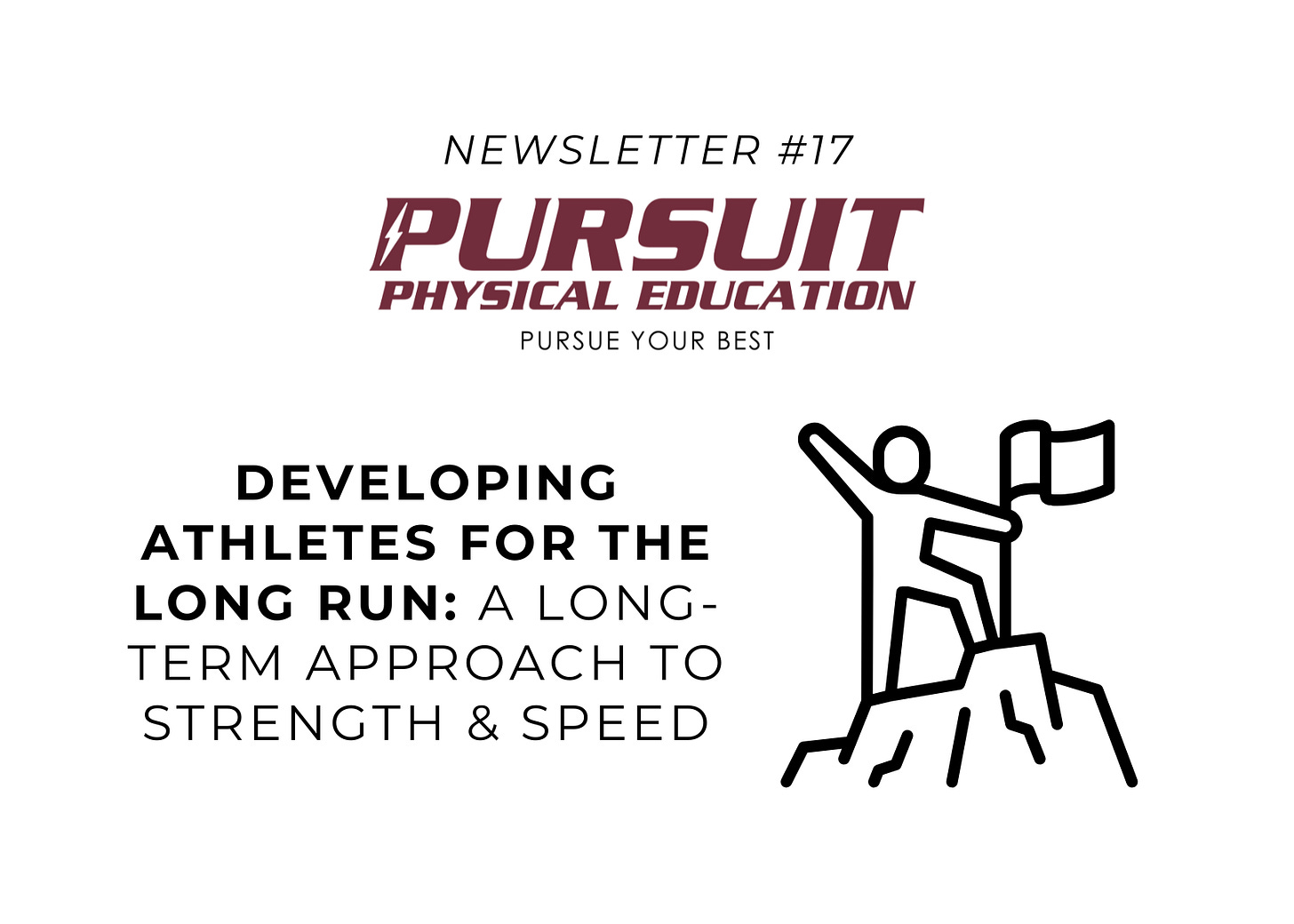Developing Athletes for the Long Run: A Long-Term Approach to Strength & Speed
#17 - Strength & Speed Coaching – Pursuing Your Best ⚡
When working with young athletes, it’s easy to focus on immediate performance—lifting more, running faster, winning the next game. But the best programs don’t just build athletes for the next season—they develop movement, durability, and resilience that will serve them for a lifetime.
Developing well-rounded, injury-resistant athletes requires a structured approach that meets them where they are and progresses them at the right time. This is where the Long-Term Athletic Development (LTAD) model comes in.
The LTAD model, developed by Dr. Istvan Balyi, is widely used to guide athlete development. It provides a roadmap for training progression, ensuring that athletes train at the right intensity at the right time. By following this model, coaches can optimize development, reduce injury risk, and promote long-term success.
Here’s how LTAD applies to Strength & Speed training and how you can structure your program to maximize athlete progression and sustainability.
The Seven Stages of LTAD in Strength & Speed Training
Understanding these stages allows coaches to align training with an athlete’s physical and developmental needs.
Active Start (Ages 0-6)
Focus: Play-based movement, fundamental motor skills (running, jumping, throwing, catching).
Strength & Speed Application: Active play that builds coordination, balance, and body awareness—no formal training at this stage.
FUNdamentals (Ages 6-9 for boys, 6-8 for girls)
Focus: Agility, balance, coordination, speed (the ABCs of athleticism).
Strength & Speed Application: Bodyweight movements, fun obstacle courses, light resistance training using medicine balls or bands.
Learn to Train (Ages 9-12 for boys, 8-11 for girls)
Focus: General athletic skills and basic strength development.
Strength & Speed Application: Introduction to structured training, focusing on technique in fundamental movements like squats, lunges, and push-ups. Sprint mechanics and plyometrics are introduced.
Train to Train (Ages 12-16 for boys, 11-15 for girls)
Focus: Building speed, strength, and stamina as bodies mature.
Strength & Speed Application: Progressive resistance training, structured sprint and agility work, and the introduction of Olympic lift variations.
Train to Compete (Ages 16-18+)
Focus: Refining sport-specific skills and developing peak athletic performance.
Strength & Speed Application: Advanced strength training, power development, sprint and conditioning work to prepare for competitive success.
Train to Win (Ages 18+)
Focus: Maximizing performance at the highest level for elite athletes.
Strength & Speed Application: High-performance training, sport-specific peaking cycles, and advanced recovery protocols.
Active for Life (Any age after sport participation ends)
Focus: Maintaining fitness, movement quality, and lifelong physical activity.
Strength & Speed Application: Transitioning from competitive training to general fitness, mobility work, and sustainable health practices.
How to Apply LTAD to Your Strength & Speed Program
If you work with middle school or high school athletes, your job isn’t just to train them for the current season—it’s to prepare them for sustained progress while ensuring they build a foundation that lasts.
Here are key ways to apply LTAD principles to your program:
Match Training to Developmental Stages
Younger athletes need movement quality, coordination, and athletic foundations before progressing to structured lifting.
Older athletes can handle higher-intensity training, but movement efficiency should always remain the priority.
Avoid Rushing Strength Development
Just because an athlete can lift heavy doesn’t mean they should.
Strength progression should always follow proper movement mechanics and physical maturity.
Early-stage athletes should master relative strength (bodyweight control) before progressing to external loads.
Prioritize Speed & Power at All Ages
Speed is one of the most trainable qualities in young athletes and should be developed early.
Sprint mechanics and explosive training should be staples of every training cycle.
Use a Long-Term Mindset, Not a Quick-Fix Approach
Short-term gains should never come at the cost of long-term development.
Overloading too soon, neglecting recovery, or overemphasizing strength at the expense of movement quality can lead to injury and burnout and overuse injuries.
Teach Recovery & Longevity Principles
Educate athletes on nutrition, sleep, and recovery strategies.
Help them develop habits that extend beyond sports and prepare them for lifelong health.
Final Thoughts: Start with One Adjustment This Week
Long-term development starts with small, intentional changes. Choose one adjustment to make in your program this week:
Focus more on movement quality in warm-ups and skill sessions.
Implement a structured progression for speed training rather than random sprint drills.
Add an educational piece to your program—help athletes understand why training with a long-term focus benefits them beyond high school.
The best Strength & Speed programs don’t just build stronger athletes for today—they develop durable, resilient, and well-rounded individuals for the future.
What’s Next in the Series?
Next up: From Middle School to Varsity: When to Progress Strength & Speed Training
Key indicators that show an athlete is ready for more advanced training.
How to structure progressions from middle school to varsity-level performance.
Signs that an athlete needs more time before progressing.
If this newsletter was helpful, forward it to a coach, PE teacher, or administrator who might benefit. The more we invest in long-term athlete development, the better results we’ll see.
Until next time—keep pursuing excellence!
– Preston ⚡️
P.S. Need Help Implementing Long-Term Athlete Development?
If you’re looking to refine your Strength & Speed approach, I offer consulting for PE teachers and coaches. Whether you need:
Program structure adjustments to match LTAD stages,
Help with tracking progress and KPIs,
A balanced approach to training, performance, and injury prevention,
I can provide personalized guidance to support your goals.
Interested? Hit reply and let’s discuss how we can improve your program together.






